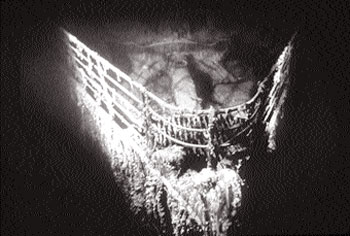Steel-munching bacteria attacks Titanic
Guardian News Service
The newly identified bacteria, isolated from 'rusticles' on the
Titanic, could also damage vital underwater installations such as
offshore oil and gas pipelines It may have been an iceberg that sunk the
Titanic but it is a bacterium that is slowly destroying its remains on
the ocean floor.
|

The bacteria can also be dangerous to vital underwater
installations such as offshore oil and gas pipelines |
Microorganisms collected from a 'rusticle' " a structure that looks
like an icicle but consists of rust " are slowly destroying the iron
hull of the liner on the seabed 3.8km below the Atlantic waves where it
plummeted, killing 1,517 people, in April 1912.
The newly identified species, while potentially dangerous to vital
underwater installations such as offshore oil and gas pipelines, could
also offer a new way to recycle iron from old ships and marine
structures, according to the researchers from Dalhousie University in
Halifax, Canada, and Seville University in Spain.
The discovery of the bacterium, now named Halomonas titanicae, will
be reported in the International Journal of Systematic and Evolutionary
Microbiology on Wednesday.
When the researchers tested its rusting ability in the lab, they
found that it was able to adhere to steel surfaces, creating knob - like
mounds of corrosion products.
A similar process is thought to be responsible for the formation of
the rusticles on the hull of the Titanic. They appear to be solid
structures but are highly porous and support a complex variety of
bacteria, suggesting that H. titanicae and other organisms may
accelerate the corrosion of steel.
Lead researchers Bhavleen Kaur and Henrietta Mann from Dalhousie
University say the role of microbes in this process is only now starting
to be understood.
"We believe H. titanicae plays a part in the recycling of iron
structures at certain depths.
This could be useful in the disposal of old naval and merchant ships
and oil rigs that have been cleaned of toxins and oil-based products and
then sunk in the deep ocean."
The scientists believe the findings could have applications for
industry. "We don't know yet whether this species arrived aboard the RMS
Titanic before or after it sank.
We also don't know if these bacteria cause similar damage to offshore
oil and gas pipelines.
The Hindu |



